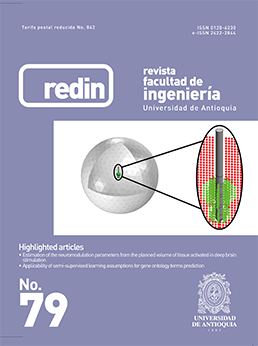Seguimiento del punto de máxima potencia basado en modelo para generadores eólicos
DOI:
https://doi.org/10.17533/udea.redin.n79a08Palabras clave:
generación eólica, resistor libre de pérdidas, sistema eólico multi-máquina, optimización de potenciaResumen
En este artículo se presenta una estrategia de seguimiento del punto de máxima potencia, basada en modelo para generadores eólicos. La estrategia utiliza el concepto del resistor libre de pérdidas y un modelo del generador, el cual representa la impedancia de carga requerida para producir la máxima potencia posible en la velocidad del rotor del generador. Los resultados de la estrategia son validados a través de simulación y una emulación de un sistema con múltiples aerogeneradores. Con la estrategia propuesta es posible extraer la máxima potencia de cada generador y, por lo tanto, la máxima potencia del sistema de generación.
Descargas
Citas
L.A. Barroso, H. Rudnick, F. Sensfuss, P. Linares, “The Green Effect”. IEEE Power Energy Mag. Vol. 8. 2010. pp. 22-35.
R. Moreno, G. Strbac, F. Porrua, S. Mocarquer, B. Bezerra. “Making Room for the Boom”. IEEE Power Energy Mag. Vol. 8. 2010. pp. 36-46.
M.A. Abdullah, A.H.M. Yatim, C.W. Tan, R. Saidur. “A Review of Maximum Power Point Tracking Algorithms for Wind Energy Systems”. Renew. Sustain. Energy Rev. Vol. 16. 2012. pp. 3220-3227.
S. Musunuri, H.L. Ginn. “Comprehensive Review of Wind Energy Maximum Power Extraction Algorithms” IEEE Power and Energy Society General Meeting. 2011. pp. 24-29.
Y. Zhu, M. Cheng, W. Hua, W. Wang. “A Novel Maximum Power Point Tracking Control for Permanent Magnet Direct Drive Wind Energy Conversion Systems”. Energies. Vol. 5. pp. 1398-1412.
C.T. Pan, Y.L. Juan. “A Novel Sensorless MPPT Controller for a High-Efficiency Microscale Wind Power Generation System”. IEEE Trans. Energy Convers. Vol. 25. 2010. pp. 207-216.
J. Hui, A. Bakhshai. “A New Adaptive Control Algorithm for Maximum Power Point Tracking for Wind Energy Conversion Systems”. Power Electronics Specialists Conference. 2008. pp. 4003-4007.
A. Cid-Pastor, L. Martínez-Salamero, A. El Aroudi, R. Giral, J. Calvente, R. Leyva, “Synthesis of Loss-Free Resistor based on Sliding-Mode Control and its Applications in Power Processing”. Control Eng. Pract. Vol. 21. 2013. pp. 689-699.
Shmilovitz, D. “On the Control of Photovoltaic Maximum Power Point Tracker via Output Parameters”. IEE J. Electr. Power Appl. Vol. 152. 2005. pp. 239-248.
K. H. Ahmed, B. W. Williams, “Different Torque Ripple Reduction Methods for Wind Energy Conversion Systems Using Diode Rectifier and Boost Converter”. IEEE International Electric Machines & Drives Conference. 2011. pp. 729–734.
R. W. Erickson, D. Maksimovic. “Fundamentals of Power Electronics”. 2nd. ed. Ed. Springer Science & Business Media. 2007.
D. Gonzalez, C. Ramos-Paja, R. Giral. “Improved design of sliding mode controllers based on the requirements of mppt techniques”. IEEE Trans. Power Electron. Vol. PP. 2015. pp. 1–1. Article in press.
Descargas
Publicado
Cómo citar
Número
Sección
Licencia
Derechos de autor 2016 Revista Facultad de Ingeniería Universidad de Antioquia

Esta obra está bajo una licencia internacional Creative Commons Atribución-NoComercial-CompartirIgual 4.0.
Los artículos disponibles en la Revista Facultad de Ingeniería, Universidad de Antioquia están bajo la licencia Creative Commons Attribution BY-NC-SA 4.0.
Eres libre de:
Compartir — copiar y redistribuir el material en cualquier medio o formato
Adaptar : remezclar, transformar y construir sobre el material.
Bajo los siguientes términos:
Reconocimiento : debe otorgar el crédito correspondiente , proporcionar un enlace a la licencia e indicar si se realizaron cambios . Puede hacerlo de cualquier manera razonable, pero no de ninguna manera que sugiera que el licenciante lo respalda a usted o su uso.
No comercial : no puede utilizar el material con fines comerciales .
Compartir igual : si remezcla, transforma o construye a partir del material, debe distribuir sus contribuciones bajo la misma licencia que el original.
El material publicado por la revista puede ser distribuido, copiado y exhibido por terceros si se dan los respectivos créditos a la revista, sin ningún costo. No se puede obtener ningún beneficio comercial y las obras derivadas tienen que estar bajo los mismos términos de licencia que el trabajo original.










 Twitter
Twitter